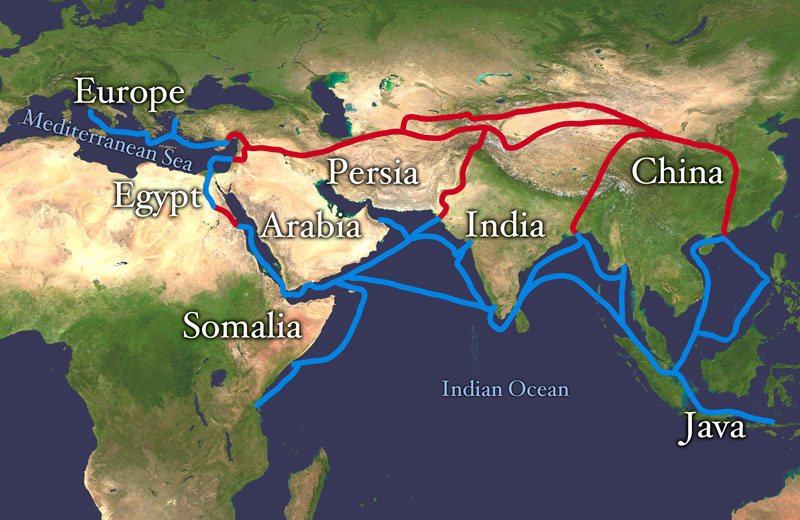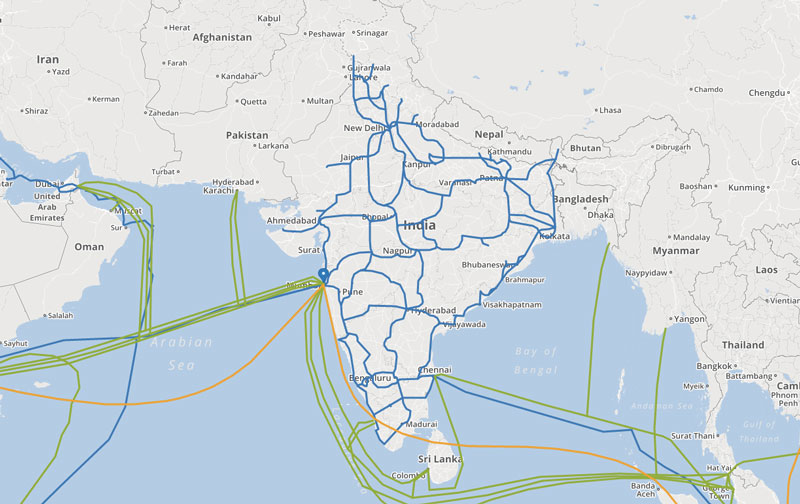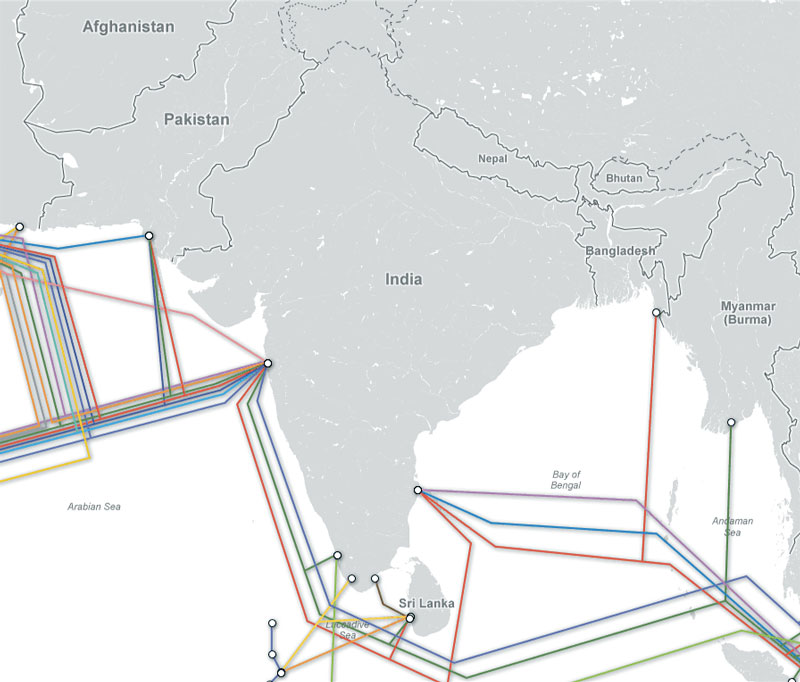India has given too much value and importance to the Internet, as growth of India started right after Internet revolution. We wondered — how much time do people really spend online? What do people really know about the Internet, like where does it come from, how does it work, and how is India connected to the Internet?
Let’s dive into the world of networking — the actual networking.
How does the Internet reach India? Where does Indian ISPs (Internet Service Providers) or our Internet wala or Broadband wala receives internet from?

As of 30 June 2017, India successfully owned around 2,933 Gbit/s of international internet bandwidth, which is expected to multifold by next decade.
India, with the world’s second-largest internet user base, is poised to reach a significant milestone in 2024. By then, half of its population will be online monthly. This populous and diverse market will see 653 million internet users this year.
If you think that satellites are the only reasons we all communicate over the Internet, then you are partially wrong. In reality, more than 99% of internet traffic transmit through high-quality and high-speed undersea fiber optic cables that connect us to all other countries.
Only a small amount of internet traffic travels through satellites; those are very limited to satellite call, our location system which is GPS (Global Positing System), etc.


These undersea internet cables are laid and maintained by many large companies.
Such projects are usually undertaken by multiple companies due to the enormous cost of investment. Due to this, such companies are known as Tier 1 ISPs, which connects two or more national boundaries via sea. After that, Tier 2 and Tier 3 ISPs are responsible for spreading the internet to businesses and individuals for home use.
Each tier differentiates the size of the network held by a company.
Tier 1 ISP.
These are the companies that have a global network, connecting so many cables around the world that they don’t need to pay anyone any fee to access any destination on the internet. But the infrastructure cost is huge, so they lend it to the all tier of ISPs.
They usually can access the network of other tier 1 ISP companies without paying any fee. The network at this tier acts as the backbone of the internet.
In India, we have Bharti Airtel Limited, Tata Communications Limited, Reliance Jio Infocomm Limited, and VSNL (Videsh Sanchar Nagam Limited) as Tier 1 ISP.
Tier 2 ISP.
These are companies that have regional networks and are usually connected to one or more tier-1 networks. They have to pay a fee to access the tier 1 company’s network.
In India, we have many tier 2 ISPs, and they handle state or multi state level of connectivity. Here in India, many tier 1 ISP also act as tier 2 ISP as they have network inside the country also, and they manage both level of connectivity at the same time.
Tier 3 ISP.
These are the Internet Service Providers (ISPs) from whom we buy our broadband connections. They are the last tier, connecting the internet to the end-users.
Such ISPs offer us internet connectivity at very affordable rates.
In India, you’ll find many local ISPs, who manages connectivity at city or village level.
How Is India Connected to the World?
India is connected to the world from Mumbai, Cochin, Chennai, and Tuticorin. These are the strategic location from where we access the global network connection. All of our international internet traffic goes through these port cities. The place where the international cables connect to the land is called landing stations.
- Tata Communications owns 3 landing stations at Mumbai, 1 in Chennai, and 1 in Cochin. So they have total 5 landing stations.
- Reliance Jio owns 2 landing station, 1 at Mumbai near versova beach and 1 in Chennai.
- Bharti Airtel owns 2 landings stations, 1 at Chennai and 1 at Mumbai.
- Sify Technologies owns 1 landing station at Mumbai.
- BSNL owns 2 landing station at Tuticorin connecting to Srilanka. Recently they added one more sea cable from Chennai to Andaman & Nicobar islands (inland network).
- Vodafone (Vodafone Idea) have 1 landing station in Mumbai.
Overall, Tata Communications have better connectivity in India, this is the reason why they offer affordable and most robust internet services.
On the eastern side, we are connected to Singapore from Chennai. On the western side, we are connected through cables connecting UAE and Mumbai. And, on the southern side, we are connected to the cables coming from South Africa.
Handing over of traffic from one network to another is called peering.
There is a non-profit government organization in India called the National Internet Exchange of India (NIXI) which allows Indian ISPs to use each other’s networks in an efficient manner rather than using foreign servers. This also increases the quality of service for the consumers and decreases the chances of data being snooped by foreign agencies such as NSA. NIXI created INRegistry in 2005 to start .in domain (the website names with .in extension).
Networks Within India.
There are several networks within India, one of them is RailTel – a government project started in 2000 to lay fiber optic cables along the routes of the railway tracks.
These cables are capable of bandwidth up to 400 Gbps and have redundancy systems that re-routes the traffic in case of any malfunction at any point.
They have a network of over 30,000 KM.
Bharat Net a.k.a. National Optical Fiber Network.
This is a project started in 2011 by the UPA Government to connect over 2,50,000 Grama Panchayaths via high-speed fiber optic cable at a cost of Rs 20,000 crore.
Later this project took over by NDA Government and modified flaws and terms found in NOFN and named it as Bharat Net and made the whole operation smooth.
The plan was to use the existing optical fiber networks of RailTel, BSNL, and PowerGrid to extend the network to more locations. The aim is to bring a minimum of 100Mbps connectivity to each Grama Panchayath.
The biggest hurdle is stated as ‘right of way problem’ which in simple words means people are not allowing to lay cable over their land.
Internet Usage.
India used 967 petabytes per month in 2014 and is increasing at a rate of 33% per year.
It is expected that it will grow to 4 Exabytes by 2019. According to a newspaper report from 2013, India has a total international bandwidth of 33,900 Gb/Second, although only around 6,009Gbps are ready to use while only 1,110Gbps are consumed.
Certainly, these figures must have increased by now.
Check the Internet Routes on Your Computer.
If you are on a PC running Microsoft Windows:
- Open your command prompt (search CMD in Windows search).
- Type
tracert google.com
If you are on a macOS or Linux system:
- Open Terminal
- Type
traceroute google.com

You will now see the IP addresses of all the devices through which you are connected to Google’s server, along with the response time it took at each stage. This helps in knowing the path/cables through which your information is being passed.
You can try some other websites too; IMO you should try other than Google.
That was a small peep into the world of underwater/underground cables – although they are essential for the internet to work, these are some things which many people are unaware of. I hope my this research will help you understand how India is connected to the internet and how we are able to access the internet from our home.
Leave a Reply